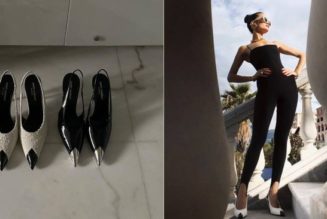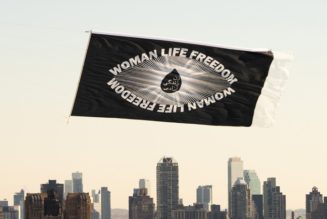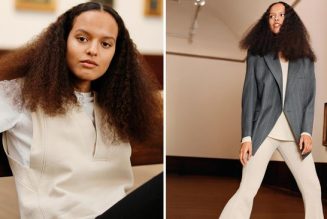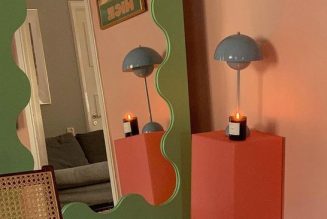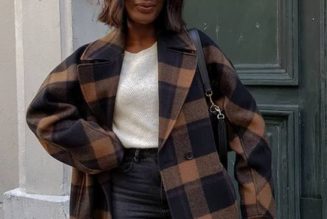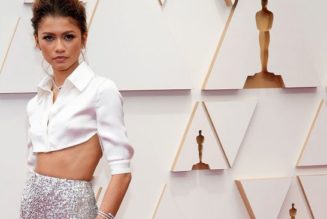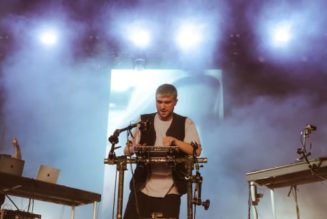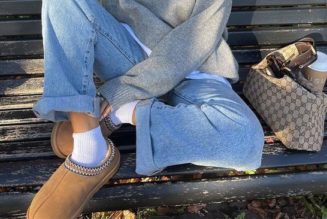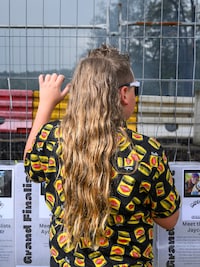
KURRI KURRI, Australia — Leah Jachmann watched anxiously as her son lined up onstage next to the other contestants. Jedrik was only 7 years old, but he’d spent most of his life preparing for this moment. An emcee handed him a microphone, and the boy quietly introduced himself.
Then it was showtime.
Jedrik turned to the side, revealing 18 inches of wavy locks that tumbled from the back of his head like a light brown waterfall. The awestruck emcee asked what his secret was.
“Mullet juice!” Jedrik’s mother shouted from the audience. “Homemade mullet juice. Rainwater, conditioner and coconut oil.”
As the crowd cheered, Jedrik spun and shook his mane as if he were in a shampoo commercial.
Welcome to Mulletfest, where Australia lets its hair down — and wholeheartedly embraces its bogan, or redneck, side.
Australians, some too young to walk, competed in Mulletfest’s grand final this past weekend across a range of categories, including “extreme,” “grubby,” “everyday” and “ranga,” a derogatory Aussie nickname for a redhead.
The mullet — short on the sides, long in the back — is not an Australian invention. The ancient Greeks were said to be partial to the ‘do, as was singer Billy Ray Cyrus and, more recently, Joe Exotic of “Tiger King.” The Beastie Boys arguably popularized the term in 1994 with their song “Mullet Head.”
But no society has embraced the mullet quite like Australia, where the cut enjoyed cult status in the 1980s. It made a comeback during the covid-19 pandemic, when Australians endured some of the world’s most restrictive lockdowns. The hairstyle, often dubbed “business in the front, party in the back,” was perfect for DIY cuts and endless Zoom calls.
With its edgy vibe, the mullet also suited what seemed like an apocalyptic moment. What better haircut for the End Times than the one sported by Mel Gibson’s Mad Max?
A new generation of Australian sports stars with the style has only added to the cachet.
Here, the mullet isn’t just a hairstyle. It’s a lifestyle.
“It means you’re an easygoing bloke,” said Benny Hill, a Mulletfest contestant whose graying locks had been shorn into two mohawks and a foot-long mop in the back. “If a fella with a mullet tells you he doesn’t care about something, you can 100 percent guarantee he doesn’t.”
Mullets are often associated with larrikins, an Australian word for a lovable rogue that began with 19th century gangsters who gave themselves ostentatious haircuts. It has since taken on a life of its own.
“It’s got this macho feeling to it,” said Ailsa Weaver, a fashion expert at the University of Technology Sydney. “This stridently, unapologetically Australian, cut-the-apron-ties-to-Britain attitude.”
The mullet is also practical, Hill said.
“With all this hot Aussie sun, you don’t have to worry about putting sunscreen on the back of your neck,” added the 41-year-old, who goes by the nickname “Keg.”
A mullet haven
When Laura Johnson was training to be a hairdresser in the 1990s, she was told to talk people out of getting mullets.
But six years ago, she and her husband were puzzling over ways to save the pub they’d bought in the small town of Kurri Kurri, north of Sydney, where the local aluminum smelter had shut down. A friend asked whether men in the town, population 6,000, compared their mullets. And an idea was born.
In 2018, Johnson held the first Mulletfest, with 100 contestants.
“People were literally walking past each other and saying, ‘Oh my god, that’s a fully thick mullet, can I buy you a beer,’” she said.
Businesses enjoyed their busiest day of the year, and the town council got on board.
The mullet — and Mulletfest — has outlasted the pandemic. In 2021, the festival, which raises money for brain cancer research, moved from the pub to a more covid-resistant location, a former coal mine a few miles from town.
The new spot has another advantage: space for burnouts. On Saturday, mullet-clad children climbed trash bins and metal fences to get a good look as muscle cars shredded their tires.
The grand final was the culmination of local mullet competitions around the country. Amid the acrid tire smoke and rock music, Lynne Fry walked around with pride.
The 63-year-old had sported a mullet since she was 10. For years, she’d had to pull it back into a ponytail while working government jobs. Then she saw the inaugural Mulletfest winner on TV and decided to enter. The next year, her three-foot gray mane earned her the “extreme” award.
“It was so nice to see people from every walk of life with the same haircut,” she said. “I’m accepted and not looked down upon because of my mullet.”
Johnson said her festival had helped popularize the haircut and, more importantly, destigmatize it. “Five years ago when we started, mullets were so polarizing, you either loved them or hated them,” she said. “Now, I think we’re sort of getting past that.”
That doesn’t mean that all mullets are equal, however.
This year, Fry served as one of Mulletfest’s three judges, evaluating the condition, cut and stage presence.
There were mullets a few inches long and others down to their owners’ waists. Some were peroxide blond, others neon red or green. There were baby mullets and balding mullets.
“In another couple of years, it’ll be a skullet,” quipped one older contestant as he ruffled his receding white locks for the judges.
There was a “rookie” category for adults who had only had the hair style for two years or less; “vintage” for people 50 years or older; and “extreme,” for the boldest of looks.
Hadrien Le Roy, whose glam rocklike ginger mane won him the “ranga” category, didn’t seem to take offense at the pejorative label. The Frenchman, dressed in a leopard-print suit, said he’d decided to don a mullet after getting his Australian citizenship — and after getting drunk. His hairstyle horrified some friends back in France but hardly raised an eyebrow in Australia.
“It’s just another day Down Under,” he said.
One mullet to rule them all
The “grungy” category had only one person show up, who nonetheless stripped down to his beer-branded “budgie smugglers,” or speedos, in celebration.
“I like getting naked, and I have a mullet,” explained 24-year-old Shaun Jackson with a shrug.
Other categories were more contested. Many of them were filled with mullets that had already won local heats held across the country. The “rookie” title went to a midwife named Lisa Wright who had won an online competition and brought a 40-person entourage in matching T-shirts.
Hill, who won the “extreme” category last year, lost his crown to a guy with a beer logo shaved into the side of his head.
Perhaps the toughest contest was for the best “everyday” mullet, which had drawn die-hard mulleteers from across the country, including one who had slept in a park gazebo on the journey.
The crown went to Mitch White, a welder who had never had another hairstyle. The 25-year-old had grown up in a small town getting his sides shaved by his father, Bevan. After Mitch moved away, haircuts became a rare opportunity to catch up.
Last year, his dad won the vintage category, but Mitch had gone home empty-handed. This time, Mitch not only won, he also took home the festival’s top prize: “Best Overall Mullet.”
Father and son grew teary as they embraced, but not before Mitch chugged a beer out of his wooden trophy.
“Good on ya’ mate!” said Jachmann, whose son Jedrik had won his own silverware. “You and your dad have got glorious poodle mullets.”
“Thank you,” Mitch said, shaking the beer out of his curls. “The apple doesn’t fall far from the tree.”

